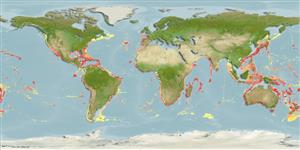Classification / Names
Common names from other countries
Main reference
Size / Weight / Age
Max length : 200 cm SL male/unsexed; (Ref. 6181); common length : 150 cm SL male/unsexed; (Ref. 6181); max. published weight: 45.0 kg (Ref. 3403)
Environment
Marine; benthopelagic; oceanodromous (Ref. 51243); depth range 200 - 1100 m (Ref. 44037)
Climate / Range
Deep-water, preferred 27°C (Ref. 107945); 50°N - 56°S, 180°W - 180°E (Ref. 6181)
Distribution
Tropical and temperate seas of the world, but probably not occurring in the northern Indian Ocean. Northwest Atlantic: Canada (Ref. 5951). Eastern Atlantic: known from 13°N off Guinea to Lobutu, Angola (Ref. 10816).
Countries | FAO areas | Ecosystems | Occurrences | Introductions
Short description
Dorsal
spines
(total): 8 - 9;
Dorsal
soft rays
(total): 16-18;
Anal
spines: 1-2;
Anal
soft rays: 12 - 14;
Vertebrae: 31. Body almost uniformly dark brown, becoming almost black with age. Pelvic fins well developed, with I spine and 5 soft rays (Ref. 9784). Prominent lateral keel on caudal peduncle, flanked by smaller accessory keels above and below (Ref. 26938).
IUCN Red List Status (Ref. 115185)
Threat to humans
Harmless
Human uses
Fisheries: minor commercial
More information
ReferencesAquacultureAquaculture profileStrainsGeneticsAllele frequenciesHeritabilityDiseasesProcessingMass conversion
Tools
Special reports
Download XML
Internet sources
Estimates of some properties based on models
Phylogenetic diversity index
PD50 = 1.0000 many relatives (e.g. carps) 0.5 - 2.0 few relatives (e.g. lungfishes)
Trophic Level
4.3 ±0.67 se; Based on food items.
Resilience
Low, minimum population doubling time 4.5 - 14 years (Assuming tm=4-5)
Vulnerability
Very high vulnerability (85 of 100)
Price category
